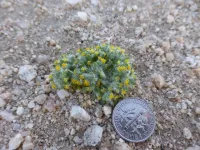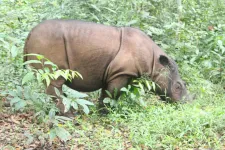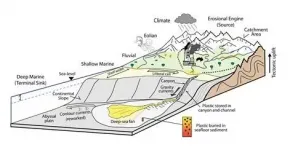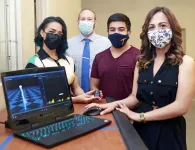Solar development: super bloom or super bust for desert species?
Rare desert plants more sensitive to solar development
2021-05-04
(Press-News.org) Throughout the history of the West, human actions have often rushed the desert -- and their actions backfired. In the 1920s, the Colorado River Compact notoriously overallocated water still used today by several western states because water measurements were taken during a wet period.
More currently, operators of the massive Ivanpah Solar Electric Generating System in the Mojave Desert are spending around $45 million on desert tortoise mitigation after initial numbers of the endangered animals were undercounted before its construction.
A study published in the journal Ecological Applications from the University of California, Davis, and UC Santa Cruz warns against another potential desert timing mismatch amid the race against climate change and toward rapid renewable energy development.
"Our study suggests that green energy and species conservation goals may come into conflict in California's Mojave Desert, which supports nearly 500 rare plant species as well as a rapidly expanding solar industry," said lead author Karen Tanner, who conducted the work as a Ph.D. student at UC Santa Cruz under a grant led by UC Davis assistant professor Rebecca R. Hernandez.
Tanner spent seven years teasing out the demography of two native desert flowers -- the rare Barstow woolly sunflower (E. mohavense) and the common Wallace's woolly daisy (E. wallacei), comparing their performance both in the open and under experimental solar panels. The authors wondered, how would desert-adapted plants respond to panels that block light and rainfall? Would rare species respond differently than common species to these changes?
These aren't easy questions to unearth. At one point, Tanner glued tiny seeds to individual toothpicks to gather emergence data. At another, she scoured the desert floor on hands and knees to count emerging seedlings of the rare sunflower -- about the size of a thumbnail at maturity.
SUPER BLOOM SURPRISES
Such painstaking commitment is one reason no previous studies have modeled species' responses to photovoltaics at the population level. It takes time and overcoming tricky logistical and mathematical challenges to model little-known species interactions in the evasive desert. What is nowhere in sight one year, may thrive the next.
That element of surprise is what makes "super blooms" so special and so captivating. Those bursts of wildflowers blanket expanses of desert landscapes after especially wet years and are believed to be critical to the long-term persistence of desert annual populations.
The study found that solar panel effects on plant response were strongly influenced by weather and physical features of the landscape. During the 2017 super bloom, panel shade negatively affected population growth of the rare species, but had little effect on its common relative.
The study suggests that rare species may be more sensitive to solar development impacts than common species. It highlights the potential for solar panel effects to vary among species, as well as over space and time.
A QUESTION OF TIME
The study provides an example of the importance of taking the necessary time to understand an ecosystem before irrevocably changing it.
"The desert -- and many other biomes -- don't respond on our timescales," said Hernandez, co-director of the Wild Energy Initiative through the UC Davis John Muir Institute. "If we want to understand them, we need to study them on the timescales they operate. Otherwise, it is like taking a photo of a moving train and calling it a shipping container. Racing to build renewable energy in places that have already been skinned of their biology makes sense -- let's not wait to put solar on existing rooftops. But in natural environments, we need to listen and observe first."
INFORMATION:
Funding for the research was provided by the California Energy Commission.
[Attachments] See images for this press release:

ELSE PRESS RELEASES FROM THIS DATE:
2021-05-04
The importance of pollinators to ensure successful harvests and thus global food security is widely acknowledged. However, the specific pollinators for even major crops - such as cocoa - haven't yet been identified and there remain many questions about sustainability, conservation and plantation management to enhance their populations and, thereby, pollination services. Now an international research team based in Central Sulawesi, Indonesia and led by the University of Göttingen has found that in fact ants and flies - but not ceratopogonid midges as was previously thought - appear to have a crucial role to play. In addition, they found ...
2021-05-04
Today, the Sumatran rhinoceros (Dicerorhinus sumatrensis) is critically endangered, with fewer than 100 individuals surviving in Indonesia on the islands of Sumatra and Borneo. To ensure survival of the threatened species, accurate censusing is necessary to determine the genetic diversity of remaining populations for conservation and management plans.
A new study reported in BMC Research Notes characterized 29 novel polymorphic microsatellite markers -- repetitive DNA sequences -- that serve as a reliable censusing method for wild Sumatran rhinos. The study was a collaborative effort involving the University ...
2021-05-04
Boulder, Colo., USA: A new focus article in the May issue of Geology summarizes research on plastic waste in marine and sedimentary environments. Authors I.A. Kane of the Univ. of Manchester and A. Fildani of the Deep Time Institute write that "Environmental pollution caused by uncontrolled human activity is occurring on a vast and unprecedented scale around the globe. Of the diverse forms of anthropogenic pollution, the release of plastic into nature, and particularly the oceans, is one of the most recent and visible effects."
The authors cite multiple studies, including one in the May issue by Guangfa Zhong and Xiaotong ...
2021-05-04
UNIVERSITY PARK, Pa. -- As more people go online for shopping, understanding how they rely on e-commerce recommendation systems to make purchases is increasingly important. Penn State researchers now suggest that it's not just what is recommended, but how and why it's recommended, that helps to shape consumers' opinions.
In a study, the researchers investigated how people reacted to two product recommendation systems. The first system generated recommendations based on the user's earlier purchases -- often referred to as content-based recommendation systems. ...
2021-05-04
EL PASO, Texas -- For more than a year, researchers at The University of Texas at El Paso's Stanley E. Fulton Gait Research & Movement Analysis Lab in the College of Health Sciences have been using real-time 3D animation to investigate motor impairments in children who have autism spectrum disorder (ASD). Their aim is to understand how children with autism can learn motor skills, so that they can receive effective therapies.
The results of their study, titled "Children With Autism Exhibit More Individualized Responses to Live Animation Biofeedback Than Do Typically Developing Children," were recently published in the journal of Perceptual and Motor Skills. The paper's release coincides with National Autism Awareness Month in April.
"The greatest takeaway from this study is that when teaching ...
2021-05-04
UNIVERSITY PARK, Pa. -- Tweaking the look of a social media profile may subtly alter a person's reaction to the health messages that appear on that site, according to researchers. They add that these reactions could influence whether the users heed the advice of those messages.
In a study, the researchers found that people who gained a feeling of control when they customized an online website were more likely to perceive the health message as a threat to their freedom, lowering the chance that they will adopt the message's advice. On the other hand, when customization bolstered the users' sense of identity, they did not resent the message as much and were more willing to consider the ads' recommended behavioral changes, according to the researchers.
"In ...
2021-05-03
Ensuring that veterans have stable housing not only reduces homelessness but also slashes the cost of providing them with publicly funded health care, according to a national study led by University of Utah Health scientists. The researchers found that veterans who received temporary financial assistance (TFA) from the Department of Veterans Affairs (VA) to acquire or retain housing had fewer hospital visits and an average reduction in health care costs of $2,800 over a two-year period than veterans who did not receive this benefit.
The researchers say this model could help non-profit organizations and other federal, state, and local governments better serve homeless Americans who are not veterans.
"Getting ...
2021-05-03
Black and Latino neighborhoods in the 30 most populous U.S. cities had fewer pharmacies than white or diverse neighborhoods in 2007-2015, USC research shows, suggesting that 'pharmacy deserts'- like so-called food deserts-may be an overlooked contributor to persistent racial and ethnic health disparities.
Pharmacies are increasingly vital points of care for essential health services. In addition to filling prescriptions to treat chronic health conditions, pharmacists dispense emergency doses of naloxone to reverse opioid overdoses, contraceptives to prevent unplanned pregnancy and COVID-19 testing and vaccinations.
But ...
2021-05-03
More than 25% of the world's population (greater than 1.5 billion people) face the burden of soil-transmitted helminth (STH) infections, a species of intestinal parasite whose eggs develop in the soil before finding a new host. The main cause of this high infection rate is lack of access to adequate sanitation facilities (toilets) and the consequent contamination of the environment with human feaces. While universal access to adequate sanitation is one of the sustainable development goals, parasite burdens are still causing harm. Fortunately, deworming medicines are highly effective and safe. Researchers from Syracuse University, the World Health Organization, ...
2021-05-03
A year into the COVID-19 pandemic, mass vaccinations have begun to raise the tantalizing prospect of herd immunity that eventually curtails or halts the spread of SARS-CoV-2. But what if herd immunity is never fully achieved - or if the mutating virus gives rise to hyper-virulent variants that diminish the benefits of vaccination?
Those questions underscore the need for effective treatments for people who continue to fall ill with the coronavirus. While a few existing drugs show some benefit, there's a pressing need to find new therapeutics.
Led by The University of New Mexico's Tudor Oprea, MD, PhD, scientists ...
LAST 30 PRESS RELEASES:
[Press-News.org] Solar development: super bloom or super bust for desert species?
Rare desert plants more sensitive to solar development




